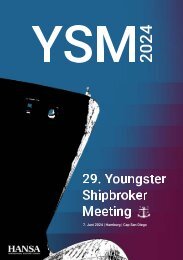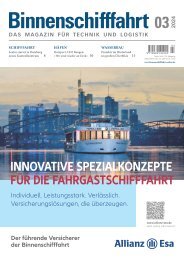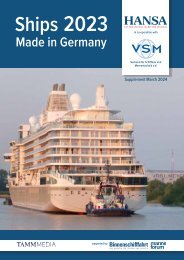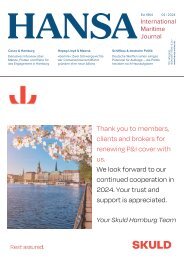HANSA 03-2018
Propeller Performance | Koalitionsvertrag | Jubiläum ZVDS | Robotik im Hafen | Ballastwasser Survey 2018 | Finanz- und Schifffahrtsstandort Nordamerika | Zeaborn & Rickmers
Propeller Performance | Koalitionsvertrag | Jubiläum ZVDS | Robotik im Hafen | Ballastwasser Survey 2018 | Finanz- und Schifffahrtsstandort Nordamerika | Zeaborn & Rickmers
Erfolgreiche ePaper selbst erstellen
Machen Sie aus Ihren PDF Publikationen ein blätterbares Flipbook mit unserer einzigartigen Google optimierten e-Paper Software.
Häfen | Ports<br />
U.S. ports demand 66 bn $ in investments<br />
Quite a few ports in the United States reported growth and positive balances recently.<br />
But despite positive circumstances and good prospects, they urge the Federal Government<br />
for huge investments. By Michael Meyer<br />
According to figures presented by AAPA<br />
(American Association of Port Authorities),<br />
U.S. seaward trade increased<br />
by 10% within the first eleven<br />
months of 2017. »Overall for<br />
2017, foreign trade tonnage was<br />
the highest it’s been since 2008,<br />
with exports experiencing double-digit<br />
growth to a record high<br />
and the fourth consecutive year of<br />
gains for imports,« AAPA President<br />
Kurt Nagle told <strong>HANSA</strong>.<br />
Experts continue to caution infrastructural<br />
deficiencies may slow<br />
down the US economic boom. Even<br />
though the Trump administration has<br />
introduced a comprehensive investment<br />
package to Congress recently, an agreement<br />
with the Democrat opposition is not expected.<br />
Some Republican party members also expressed<br />
reservations. After the Panama Canal expansion,<br />
ports consider being prepared for the launch of<br />
large container ships one of the most important issues – not merely<br />
in terms of quayside handling. Port and hinterland processing of<br />
cargo also poses problems for the operators. Traffic jams and blockages<br />
are the result cargo owners and freight forwarders complain<br />
about. In addition, ports need to invest in green technologies as<br />
harsher regulations require a reduction in emissions.<br />
Rather positively, AAPA is looking at political achievements:<br />
»AAPA is looking forward with great anticipation to a focus on<br />
America’s infrastructure investment needs by the Trump Administration<br />
and Congress in <strong>2018</strong>,« Nagle says.<br />
Seaport cargo activity accounts for 26% of U.S. GDP, over<br />
23 mill. American jobs, and generates over 320 bn $ annually in<br />
federal, state and local tax revenues. To ensure these jobs, tax<br />
revenues and freight volumes continue to grow and support the<br />
American economy, AAPA has worked to identify 66 bn $ in federal<br />
port-related infrastructure investments over the next ten<br />
years, on both the waterside and the landside. This level of federal<br />
investment into port-related infrastructure is needed to support<br />
the nearly 155 bn $ in infrastructure investments that U.S. ports<br />
and their private-sector partners plan to invest up and including<br />
2020. Federal support for land and waterside infrastructure improvements,<br />
together with security and environmental protection,<br />
are key priorities for America’s ports in <strong>2018</strong> and beyond.<br />
Nagle adds, »AAPA member ports are pleased that the Congress<br />
continues to provide strong funding for the Corps’ Navigation program,<br />
including making progress towards full use of annual Harbor<br />
Maintenance Tax (HMT) revenues.« The association is also<br />
advocating congressional appropriations in other programmes for<br />
freight transportation, port security, diesel emissions reduction<br />
grants, additional customs and border protection.<br />
Photo: AAPA<br />
As part of the »Tax Cuts and Jobs Act« bill<br />
passed 2017, AAPA says it was successful<br />
in urging Congress to maintain most tax<br />
exemptions on Private Activity Bonds<br />
(PABs) to help finance infrastructure<br />
projects. The association’s advocacy efforts<br />
also were rewarded when Congress<br />
voted to maintain the tax credit<br />
for wind energy projects. Because<br />
PABs provide a significant source of<br />
financing for port-related and municipal<br />
infrastructure projects, AAPA<br />
worked with several transportation<br />
and bond-related coalitions to advocate<br />
against the elimination of tax exempt status<br />
for PABs. »We were extremely pleased<br />
the final legislation kept PABs mostly tax-exempt.<br />
Maintaining PABs as tax-exempt will<br />
Kurt Nagle, CEO<br />
help foster investments, not just in and around<br />
American Association of Port Authorities ports, but also in needed infrastructure development<br />
throughout the nation. It was estimated<br />
that ports would have had to pay approximately<br />
19 mill. $ in extra debt service costs for every 100 mill. $ borrowed<br />
had the PAB tax exemption been lost. These significantly increased<br />
costs would have harmed ports’ ability to make needed investments,<br />
and likely would have delayed or even killed some projects.<br />
As Congress and the Trump Administration consider a broad<br />
infrastructure investment package, U.S. seaports have identified<br />
66 bn $ in necessary infrastructure investments over the next decade<br />
to keep freight moving efficiently. On the waterside, this works<br />
out to about 33.8 bn $. On the landside, the amount is estimated to<br />
be 32.<strong>03</strong> bn $. On the waterside, there is a need for 27.6 bn $ to maintain<br />
channels and harbours, and 6.2 bn $ to modernize them. Of the<br />
27.6 bn $, 18.6 bn $ would come from full use of annual HMT revenues,<br />
which includes providing more equity to donor ports, plus<br />
9 bn $ from the current HMT surplus to address the chronic dredging<br />
maintenance backlog at deep-draft ports. Of the 6.2 bn .$ modernization<br />
amount AAPA has identified, 3.1 bn $ is needed for the<br />
federal share of 15 current congressionally-authorized construction<br />
channel improvements and another 3.1 bn for the federal share of<br />
constructing projects undergoing feasibility studies.<br />
For the landside portion of the infrastructure investment need,<br />
28.9 bn $ is necessary up and including 2025 to build vital road and<br />
rail connectors, plus 3.13 bn $ to improve port infrastructure, allowing<br />
more funding for multi-modal freight projects. »A top priority,<br />
going forward, is getting Congress to make HMT spending<br />
mandatory, while addressing donor equity and tax fairness issues,«<br />
the AAPA President explains. Because U.S. ports and their<br />
private-sector partners have told AAPA they plan to invest some<br />
155 bn $ into port-related infrastructure and other capital projects<br />
between 2016 and 2020, AAPA says to continue to urge the Federal<br />
Government to make the 66 bn $ in port-related investments.<br />
78 <strong>HANSA</strong> International Maritime Journal – 155. Jahrgang – <strong>2018</strong> – Nr. 3


















